
Understanding Spear Phishing: Key Insights and Prevention Strategies
Spear phishing is a very specialized variant of email scam which parades itself as a trusted individual or organization to target people. In contrast to the generic phishing where the attacker sends mass emails to large groups of people, the spear phishing attackers do their research and send individual messages in order to make the scam look genuine.
As an example, a spear phisher can impersonate a company CEO sending an email to a company finance officer or impersonate a reputable service, such as Microsoft or Amazon. Due to the email being seemingly personally targeted, the guard of the recipient is lowered and the spear phishing scams become much more believable, which can lead to identity theft. According to security reports, spear phishing is rampant and expensive: approximately 88% of organizations experience spear phishing every year, and advanced spear phishing attacks caused significant breaches and financial fraud.
What Is Spear Phishing and How Does It Work?
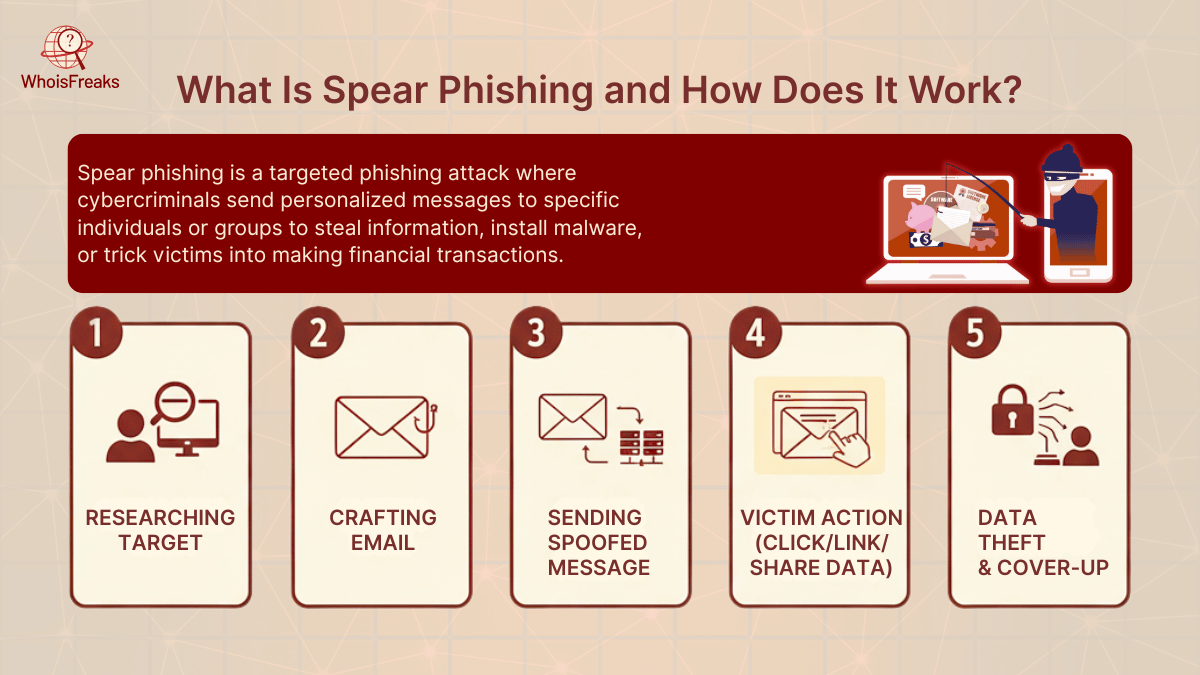
Spear phishing involves a form of targeted cyberattack on individuals or organizations, often revealing sensitive information. The attackers begin gathering sensitive information and personal information like job position, contacts, and interests of a high-value target, like an executive or financier, before collecting their personal information. With such facts, they develop a persuasive email or text that seems to be sent by a reliable individual like a colleague, supplier or a top manager.
Such messages may contain a malicious link or attachment, or it may request the victim to do a sensitive task such as sharing the login credentials or even making a payment. When the target cooperates, the attacker is capable of stealing data, obtaining unauthorized access, or inflicting financial damages, and then overwriting to cover up the tracks.
Because spear phishing is highly personalized, it often relies on social engineering using familiarity or urgency to manipulate victims. Unlike regular phishing, which targets many people at once, spear phishing focuses on a few well-researched victims for greater rewards. This makes it one of the most dangerous and effective cyber threats, emphasizing the need for strong awareness and to prevent spear phishing with effective prevention measures.
Why Spear Phishing Is Dangerous?
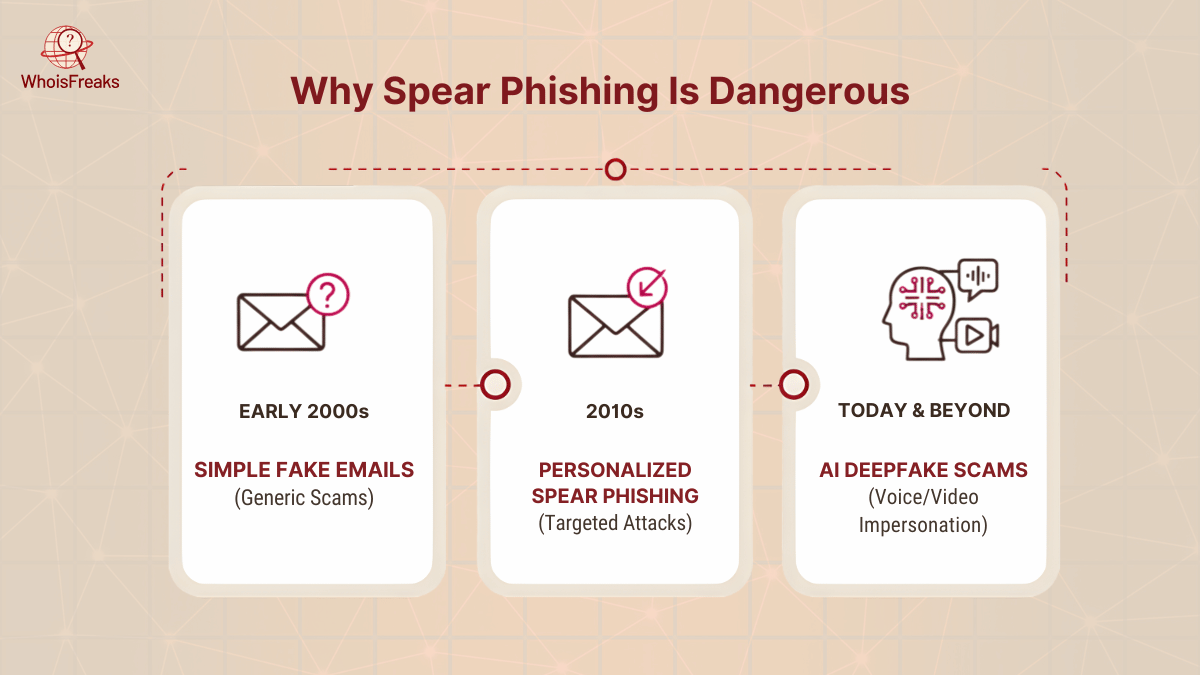
Spear phishing is alarmingly effective and on the rise. Recent threat analyses report that AI-powered spear phishing attacks are increasing, with attackers using machine learning and deepfakes to create highly convincing emails or even voice calls.
For example, attackers might use AI to generate a fake video or voice message from an executive demanding payment. According to a 2025 industry report, “highly targeted, AI-enabled spear phishing attacks are on the rise” and attackers are constantly developing new social engineering tactics
Spear Phishing Statistics and Global Trends

Statistics show that almost every organization will face spear phishing. Proofpoint notes that about 96% of phishing campaigns and phishing attacks arrive via email, and one study found that 65% of known hacking groups employ phishing and spear phishing as their favored attack vector. In fact, nearly 88% of organizations reported encountering spear phishing attempts in the past year.
According to the words of security experts, spear phishing is one of the major reasons of data breach and monetary loss. One study has determined that spear campaigns are infrequent (approximately 0.1 percent of phishing email messages), but 66% of all breaches are due to their accuracy and effectiveness. Most popular spear phishing themes are brand and executive impersonation. Popular services are frequently spoofed by attackers in order to trick victims into believing them. As an illustration, Microsoft, DocuSign, and even the internal departments such as HR are some of the best entities that have been spoofed by spear phishers.
Common Spear Phishing Tactics
Spear phishers use a variety of tactics, including spear phishing messages, to entice victims. Some of the most frequent techniques include:
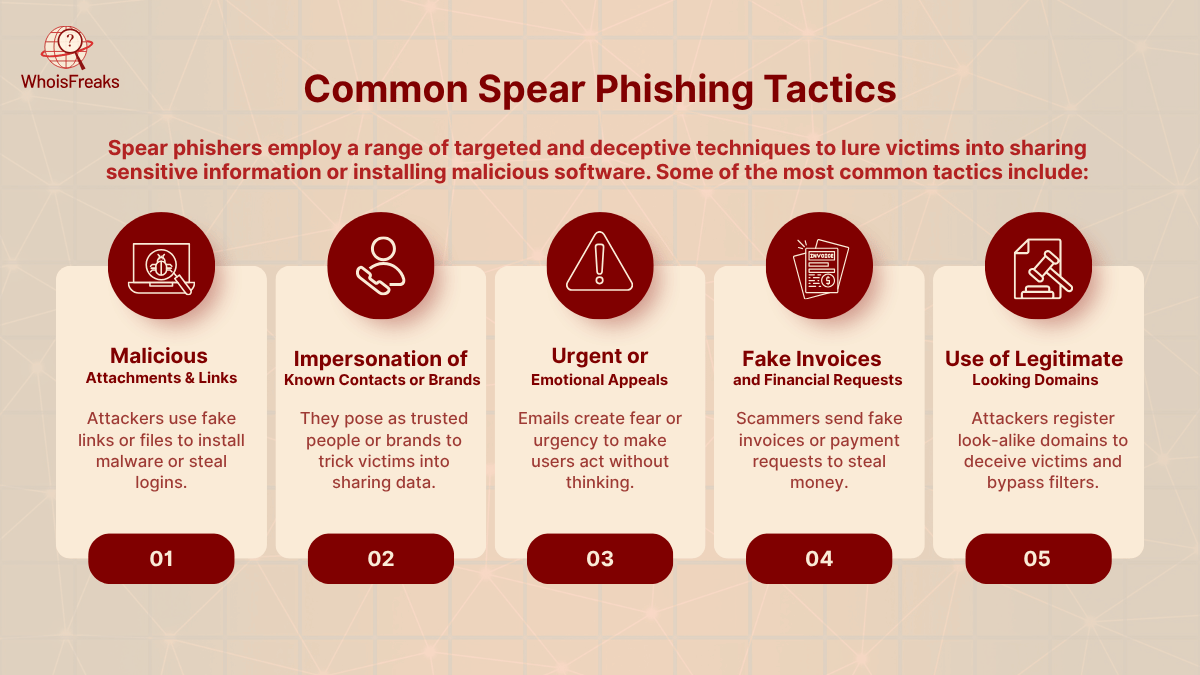
- Malicious Attachments and Links: The email may include a seemingly relevant attachment (e.g. an invoice, a PDF, or a document) or a link to a spoofed website. Recipients who open the attachment might install malware, or those who click the link might be taken to a fake login page. In fact, industry reports show that 94% of malware is delivered via email attachments, making this a very common tactic. Even if a link looks legitimate, it may be a trap.
- Impersonation of Known Contacts or Brands: Attackers often pretend to be someone the victim knows or trusts. This might be a colleague, a manager, or a vendor. For instance, an email that appears to come from “HR” might ask about vacation policies or salary changes. Or an email might claim to be from IT support needing a password. By referencing the victim’s actual work context, these messages appear far more credible.
- Urgent or Emotional Appeals: Phishing emails typically create a sense of urgency or fear. A spear-phishing email might claim that the recipient’s account will be locked unless they act immediately, or that a deadline is approaching. Emotional language (e.g. “immediately,” “urgent,” “confidential”) is designed to make people act without thinking. For example, one report found that HR-related phishing often used emotionally charged subject lines about salary or benefits to pressure recipients.
- Fake Invoices and Financial Requests: Many spear phishing attacks target finance teams with fraudulent invoices or payment instructions. The attacker might pose as a vendor and send an invoice for a service, or pose as an executive and request an urgent bank transfer. Proofpoint cites cases where attackers impersonated CEOs to trick finance employees into wiring large sums. These financial scams can have immediate monetary impact.
- Use of Legitimate-Looking Domains: Spear phishers often register domain names that look almost identical to real ones. This includes typosquatting (e.g. “paypall.com” instead of “paypal.com”), homoglyphs (substituting similar-looking characters, like using “0” for “O”), or adding extra words. Because the domain looks plausible, email filters may not catch it and victims often do not notice the small differences.
These tactics make spear phishing a versatile threat. Attackers will tailor their approach to the target. For example, tech-savvy employees might be targeted with highly sophisticated emails and fake login pages, while others might be lured by promises of financial gain or administrative requests.
Prevention Strategies and Best Practices
Combating spear phishing requires a multi-layered approach that combines technology, policies, and user education. No single solution, including antivirus software, will stop all attacks, but together they can dramatically reduce risk. Key strategies include:
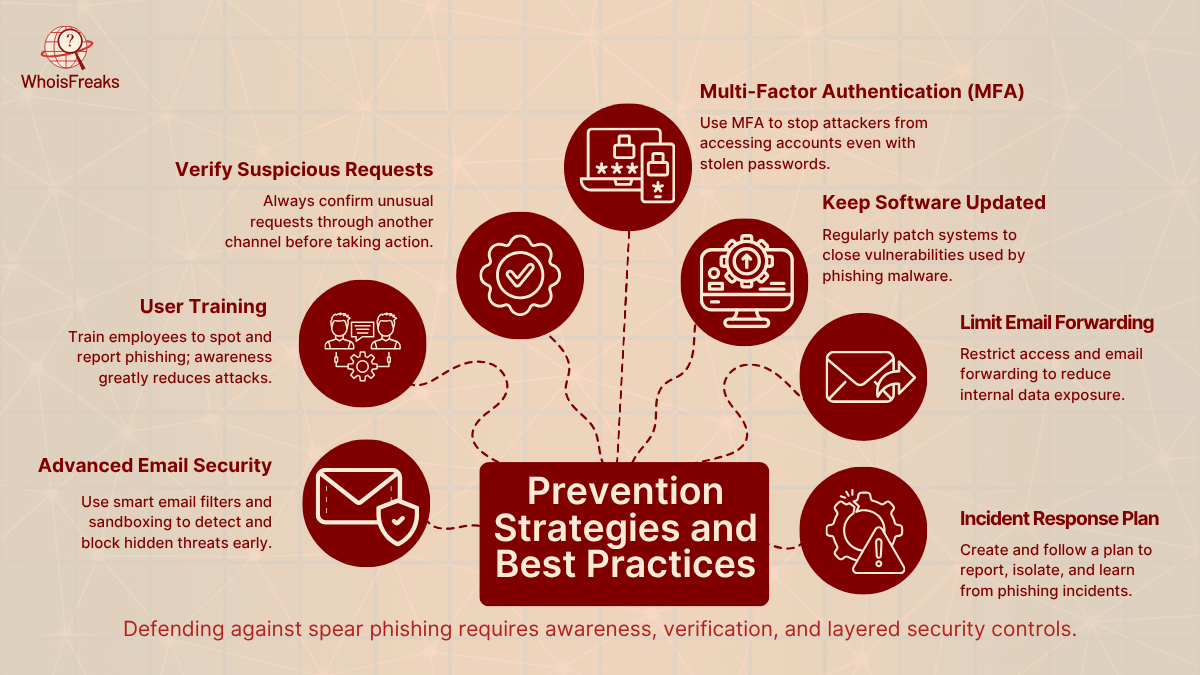
- Advanced Email Security: Deploy email filtering and protection solutions that go beyond simple spam filters. Modern tools use machine learning to analyze incoming emails for suspicious patterns, malicious attachments, and fake domains. They may automatically sandbox or emulate clicking any links to see if they lead to malware. By analyzing URLs and attachments in a safe environment, these systems can block threats before they reach users. For example, sandboxing technology detains a link or attachment and executes it in a controlled setting to detect hidden malware. According to Proofpoint, using sandboxing and dynamic analysis helps catch the most targeted threats.
- User Training and Awareness: Education is one of the most effective defenses. Regular security awareness training helps employees recognize phishing signs and know how to respond. Simulated phishing exercises are also valuable to reinforce vigilance. Research suggests that well-designed training can massively improve detection: one study found that employees who undergo focused anti-phishing training can report 6× more attacks within six months and reduce incidents by 86%. Encouraging a culture where staff feel comfortable reporting suspicious emails (instead of ignoring them) helps catch attacks early.
- Verify Suspicious Requests: Encourage a verification process for any unusual or sensitive request. If an email asks for a fund transfer or confidential information, employees should confirm it through a second channel before acting. This simple step “does this email really come from who it says it does?” can stop many scams. As one expert points out, all financial transactions should be double-checked, even if they appear to come from a trusted colleague.
- Multi-Factor Authentication (MFA): Enforce MFA on all important accounts. Even if a spear phisher steals a username/password, MFA (such as a code from a phone app or hardware token) can prevent them from logging in. Many breaches happen because attackers obtain credentials and then access systems. MFA significantly raises the bar.
- Keep Software Updated: Ensure email clients, operating systems, and security software are up-to-date. Sometimes spear phishing leads to a malware download that exploits an unpatched vulnerability. Regular patching reduces this risk.
- Limit Email Forwarding and Privileges: Restrict which user roles can receive external requests for sensitive actions (e.g. HR or accounting requests for payments) and limit automatic email forwarding (to prevent exfiltration). Use the principle of least privilege: not every employee should have the highest access.
- Incident Response Plan: Finally, have a clear plan for when phishing is detected. This includes steps for reporting, isolating affected systems, and learning from incidents to improve defenses.
Leveraging WhoisFreaks Domain Intelligence Tools
One powerful but often overlooked defense against spear phishing is domain and IP intelligence. Since attackers rely on fake or malicious domains, tracking and analyzing them can reveal early warning signs. WhoisFreaks offers a range of tools to detect, verify, and block such threats in real time. Security teams can use these tools to check suspicious domains, catch brand impersonations, and identify risky infrastructure before damage occurs.

1. WHOIS and DNS Lookup
These tools show who owns a domain and how it’s set up. A domain with a recent registration date or hidden owner can be suspicious. DNS Lookup also reveals live records like IPs or mail servers if they point to known bad sources or look unusual, that’s a red flag. Analysts can quickly check if an email or domain is legitimate or newly created.
2. Newly Registered Domains Feed
Attackers often use new domains to avoid detection. WhoisFreaks provides a daily list of recently registered domains with their WHOIS and DNS info. Monitoring for domains that mimic your brand helps catch threats early and block them before they’re used in attacks.
3. Domain and Brand Monitoring
These tools automatically watch for domains or websites using your brand name or trademarks. Alerts trigger when suspicious lookalike domains appear. They also track changes to your own domains like unexpected DNS updates that could signal tampering.
4. Subdomain Discovery and Monitoring
Some attacks use hidden or fake subdomains to trick users. WhoisFreaks’ tools can list all subdomains linked to a domain, helping analysts spot malicious setups. Regular monitoring also helps detect unauthorized domain use.
5. Security Lookup and IP Geolocation
These tools analyze IP addresses to see if they’re tied to malware, proxies, or threat networks. They also show the IP’s country and internet provider. If a phishing link or login attempt comes from a high-risk region or flagged IP, it can lead to download malware and be blocked immediately.
6. SSL Certificate and ASN Lookup
Attackers may use fake SSL certificates to appear trustworthy. WhoisFreaks' SSL Lookup reveals certificate details, such as who issued it and when it expires, helping to prevent business email compromise . ASN Lookup identifies the network that owns an IP useful for spotting connections to shady hosting providers or threat actors.
Key Takeaways
Spear phishing remains a top cyber threat because it exploits human trust and sophisticated social engineering. The attack is effective but also preventable with the right spear phishing prevention defenses in place, ensuring they can differentiate from legitimate emails . The key insights are:
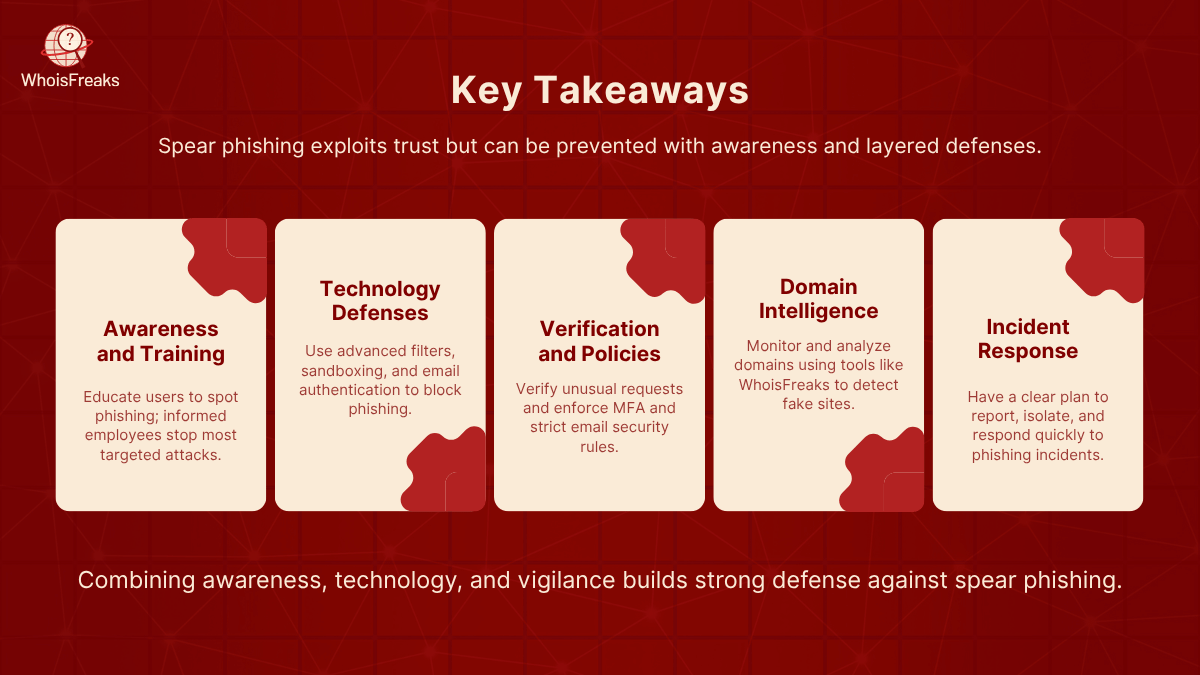
- Awareness and Training: Educating users to spot targeted phishing is crucial. Well-trained employees can dramatically reduce successful attacks.
- Technology Defenses: Use advanced email filters, sandboxing, and authentication (SPF/DKIM/DMARC) to block or flag phishing attempts.
- Verification and Policies: Always verify unusual requests, implement strict email policies, and use multi-factor authentication to limit the damage of compromised credentials.
- Domain Intelligence: Monitor for fake domains and analyze suspicious addresses. WhoisFreaks provides tools (WHOIS lookup, DNS lookup, domain monitoring, etc.) specifically for threat intelligence against phishing.
- Incident Response: Have a plan so that if a spear phishing email slips through, it can be quickly reported and contained.
By combining these strategies, organizations and individuals can build a robust defense against spear phishing. In an environment where attacks are continuously evolving, staying informed and proactive is the best protection. Using the latest security tools and maintaining a vigilant mindset will help ensure that spear phishing threats are detected early and neutralized before any security risk or harm is done.
FAQs
1. What is spear phishing?
Spear phishing is a targeted email scam where attackers pretend to be someone you know or trust to steal sensitive data, personal or company information.
2. What is the main difference between phishing and spear phishing?
Phishing targets many people with the same fake message, while spear phishing focuses on one specific person or organization using personalized details.
3. What is an example of spear phishing?
An attacker pretends to be your company’s CEO and sends you an email asking to transfer money or share confidential data.
4. What is the difference between phishing, spear phishing, and whaling?
Phishing is general and sent to many, spear phishing is targeted at specific individuals, and whaling attacks specifically target high-level executives like CEOs or directors.

Software Engineer
A software engineer focused on developing scalable, efficient solutions. Expertise in coding, system optimization, and utilizing advanced technologies for high-performance apps.
Related Posts

Understanding Domain Fronting: Benefits, Risks, an...
Explore the benefits and risks of domain fronting, its applications, and how it impacts online privacy. Read the article for a comprehensive overview.
Published at: Nov 20, 2025

Essential Strategies to Prevent Subdomain Takeover...
Learn how to prevent subdomain takeover with essential strategies and best practices. Protect your online assets—read the full guide now!
Published at: Nov 18, 2025

Understanding Cache Poisoning: Risks and Preventio...
Learn about cache poisoning risks and effective prevention strategies to safeguard your online presence. Read the article to protect your systems toda...
Published at: Nov 5, 2025